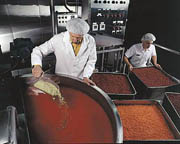
Milwaukee-based Norlight Telecommunications suggested simplifying Faribault's frame relay network with a routing protocol called multi-protocol label switching (MPLS). The change resulted in a 20% decrease in telecommunications costs despite an increase in bandwidth at three of the company's remote sites and an additional T1 line for backup between the main office and an off-site warehouse.
"Without the extra capacity and T1 line we added, we would probably be paying just $6,000 a month," says Faribault's IT Manager, Scott Bellefeuille. "In an apples to apples comparison, we actually cut our costs by one-third."
Before using MPLS, Faribault paid to maintain two permanent virtual circuits (PVCs) at each of its facilities, essentially providing two separate data paths for redundancy purposes. One path led to the company's main data center while the other led to a secondary site that served as a hot standby.
Unfortunately, since the network was configured to route all data through Faribault's host site, any outage in the main office would shut down the data flow at all facilities. Setting up a truly fail-safe backup system would have required expensive infrastructure modifications.
The MPLS system, however, eliminated the need to funnel all data through Faribault headquarters. It also enabled the company to maintain and pay for only one PVC at each facility instead of two. All data now travels over Faribault's frame relay connection to an IP network core at Norlight's data center in Brookfield, WI. MPLS routers and switches are situated at and maintained by Norlight, which then sends the information on to the appropriate destination.
"We were able to retain our existing frame relay network with no additional capital expenditures because implementation of the MPLS service was primarily a matter of reconfiguring routers. It didn't require any hardware or infrastructure changes on our end," says Bellefeuille.
MPLS routes traffic to any location by creating and attaching special labels to each data packet. Each label contains information such as the packet's origin, destination and required bandwidth. According to Norlight, routing by label, rather than packet, allows data traffic to follow multiple routes rather than a single path.
For Faribault, this means data headed for the company's primary data center can be automatically rerouted to the backup site if the primary site is out of commission. "This eliminates the need for a second PVC," says Bellefeuille. "Now one site can be down and the other six can still be working." The technology also eliminates bandwidth inefficiencies by allowing any site to talk to any other site directly.
For more information:
Kamlesh Sethi, Norlight
Telecommunications,
262-792-7789